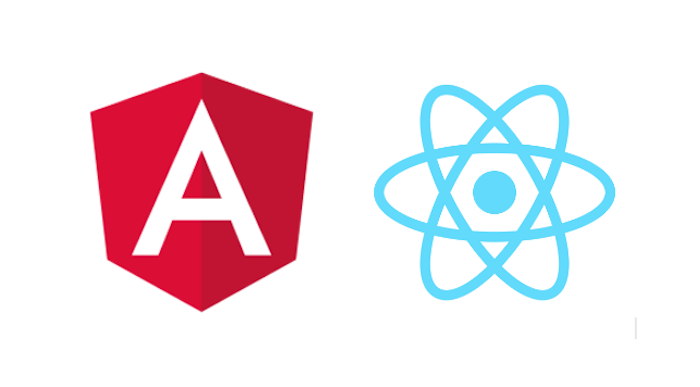In the last decade, frontend development has significantly evolved, with many new technologies and open-source development frameworks, enabling powerful business applications. The web development is dominated by the highest performance JavaScript frameworks like React, Vue, Angular, Node, Express, and Aurelia.
However, every frontend development effort starts with the difficulty of selecting two of the most prominently developed frameworks – React against Angular. Often recognized as two of the world’s most widely frequented front-end development platforms, these open-source JavaScript-based frameworks are both used by software developers to construct personalized interfaces for backend processing systems built using a variety of languages.
Let’s look at some key numbers and statistics before we analyze the react and angular performance.
-
Origin & Community
Any software developer would welcome the community’s strong support for a technology they use to create apps. On the front-end, there isn’t much change either.
So, let’s look at Angular and React. Angular is based on TypeScript, which was created by Google and is supported by a vast community.
From interactive interfaces to mobile applications, developers utilize React to build on Facebook’s Angular platform. It also has a big developer community. Both Angular and React are open-source and supported by internet giants; thus, they don’t stand out much in this area.
Many React JS and Angular JS freelancers are available on Fiverr and Upwork.
The software experts seeking to build intuitive front-end interfaces will have no problem experimenting with any of them.
Check: Angularjs development India
-
Framework Design
While both React and Angular are front-end frameworks, React is referred to as such differently.
React.js is a JavaScript library with just a view mode. The MVC design of Angular allows it to be utilized as a front-end and an end-to-end app development framework without depending on additional 3rd party libraries.
Angular has more functionality than other libraries, reducing the need for software developers to discover and integrate new frameworks.
React, on the other hand, needs React Native, a different cross-platform app development framework. React.js is a library that enables you to create dynamic front-end interfaces.
Angular is a sizeable one-size-fits-all framework for software developers to create front-end interfaces and sophisticated apps in one go.
-
Modularity and reuse
With rising development costs, businesses must create systems with as many reliable, reusable components as feasible.
This saves time and money for developers while also allowing for quicker market adoption.
Both Angular and React use a component-based design. To clarify, any app developed using these frameworks would have modular components that are tightly coupled. Reuse and mix these components to create new interface features.
Angular and React both have this feature, which is highly sought in contemporary front-end development. They both enable developers to create components quickly and expand apps on-demand without designing components from the start.
-
DB and DOM
This is a performance characteristic that affects applications developed using these frameworks. While React and Angular allow developers to create massive corporate apps, their DOM and data binding concepts vary. React.js makes use of virtual DOM, while Angular has the real DOM.
Angular development slows down dynamic updates because the actual DOM must rebuild the whole HTML table tree structure to make even small changes. However, React enables developers to update changes without rewriting HTML.
It allows for quicker rendering of interfaces and improved performance regardless of app size. Due to its actual DOM operating architecture, angular may seem sluggish when too many data queries.
Then data binding. Angular utilizes two-way data binding, whereas React uses one-way data binding. While the one-way binding is considered more reliable and debugs friendly, Angular’s two-way binding is preferred due to its ease of use. There is no apparent winner in this category since both offer benefits and drawbacks.
-
Coding Language Ease
Angular is built using TypeScript, although JavaScript may be used as well. TypeScript is a JavaScript superset that enables more advanced online business applications to be created.
Compared to plain JavaScript, it provides superior autocomplete, navigation, and code restructuring. React utilizes JavaScript ES6+ and JSX Script, a recognized UI extension.
However, the more adaptable TypeScript and familiar syntax make learning simpler for developers who have long argued that JSX is difficult to digest for novices and even seasoned experts.
Angular out codes React in terms of coding ease. It also lends itself to more extensive and more sophisticated business application development projects.
Check: hire reactjs developers India
Wrapping Up:-
In React to Angular clash, there is not much difference in most of the main pillars of front-end development. In certain places, Angular works great but React also shows its class in some situations.
It relies on the kind of application or user interface that your company intends to create. Either one has its share of benefits. You require a consultant to assess the extent of your development needs and recommend the best candidate for these two applications.
Any queries about frontend development? feel free to contact us & get a free quotation today!





Share This Article:
Written by:
Muzammil K
Muzammil K is the Marketing Manager at Aalpha Information Systems, where he leads marketing efforts to drive business growth. With a passion for marketing strategy and a commitment to results, he's dedicated to helping the company succeed in the ever-changing digital landscape.
Muzammil K is the Marketing Manager at Aalpha Information Systems, where he leads marketing efforts to drive business growth. With a passion for marketing strategy and a commitment to results, he's dedicated to helping the company succeed in the ever-changing digital landscape.